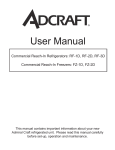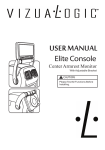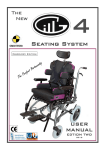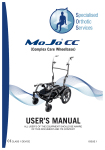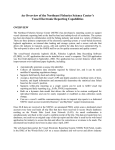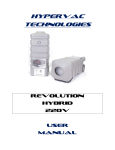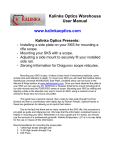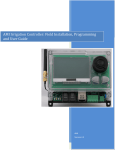Download Premium Bicycle Rollers
Transcript
TruTrainer Premium Bicycle Rollers User’s Manual CAUTION: Read all precautions and instructions before using this product. November 2005 Page 1 of 19 Important Precautions WARNING: To reduce the risk of injury or property damage, read the following important precautions before using TruTrainer rollers. 1. 2. 3. 4. 5. 6. 7. 8. 9. 10. 11. 12. 13. 14. Read all instructions in this manual before using rollers. Use rollers only as described. It is the responsibility of the owner to ensure that all users of rollers are adequately informed of all precautions. Rollers are intended for use by experienced cyclists in good health and with good bicycle handling skills. If you have health problems, do not ride these rollers without first consulting your medical doctor. If you feel pain or dizziness while exercising, stop immediately and cool down. Rollers are intended for use with road bicycles having wheelbases between 37.2 and 43.2 inches. NEVER RIDE A MOTORIZED VEHICLE ON THESE ROLLERS. It is the responsibility of the user to assure that his/her bicycle is properly maintained and in good working condition. Tires should be inflated to their recommended pressure. Use rollers on a level, non-slip surface. Place a mat under rollers to protect your floor. YOU WILL FALL FROM TIME TO TIME. Make sure that you have a safe, soft landing area when you fall. Remove all furniture and dangerous objects from your landing area. If riding on a hard floor, place a tumbling mat next to your rollers. If riding in a hall way or door way, be advised that damage to woodwork and walls is likely. C ycleDyne LLC will not be responsible for personal injuries or property damage sustained while riding on, or falling off of, our rollers. Keep pets, children, and bystanders away from rollers while riding. Spokes are nearly invisible when riding at even modest speeds. CycleDyne will not be responsible for injuries sustained to fingers, noses, tails, or other body parts that come in contact with rotating components or traveling drive belts. CycleDyne will not be responsible for injuries sustained by bystanders or pets struck by falling riders or bicycles. Rollers must not be exposed to water or dust. Permanent damage to the bearings will occur. If rollers are exposed to water, thoroughly dry them before using. ROLLERS ARE SLIPPERY WHEN WET. Rollers should not be used by persons weighing more than 250 pounds. Rollers should not be ridden at speeds exceeding 50 MPH. Wear suitable clothing when using rollers. Do not wear loose clothing that could catch on moving parts of the bicycle or rollers. Use only the rear brake when slowing or stopping. Do not use front brake. Inspect rollers for damage and properly tighten fasteners regularly. Replace worn or damaged parts immediately. Spare parts may be ordered from TruTrainer.com. November 2005 Page 2 of 19 Set-Up TruTrainer™ rollers are shipped pre-assembled. However, the following tasks must be performed before using your rollers. 1. Thoroughly inspect rollers for any damage that may have occurred during shipment. 2. Check all fasteners for proper tightness. 3. Inspect the front and rear drive belts to verify that the y are properly seated in their pulley grooves as shown below. Yes No Yes No 4. Verify that all three rollers turn freely and quietly. 5. Adjust front roller position according to your bicycle wheelbase as described in the Care and Maintenance section. Tasks 1-4 should also be performed on a periodic basis, especially after transporting the rollers. November 2005 Page 3 of 19 Getting Started Learning to ride rollers is a bit like learning to roller blade, skateboard, ski, or surf. Your first experience may be shaky but with time and practice, riding rollers will become second nature. If you are not an experienced roller rider, the following tips may help. 1. CLEAR A SAFE L ANDING AREA BESIDE THE ROLLERS. Everyone who rides rollers falls from time to time. When you fall, you fall to the side, not to the front. We recommend at least 6 feet side clearance unless you are riding in a hallway or door jam to catch your fall. Riding in a hallway or door jam is fine as long as you don't mind nicks and dings on your walls and woodwork. If you are riding on a hard floor such as concrete, tile, or wood, place a tumbling mat or thickly padded carpet beside the rollers. 2. Place the rollers with the belt side about 6-8" away from a wall. Mount your bike and place both hands on the handlebars. Rest your elbow against the wall to steady yourself. Start pedaling. As you gain speed and confidence, slowly bring your elbow in. A common mistake when first learning to start on rollers is to place one hand on the bar and the other against the wall or door jam. Everything works fine until it's time to transfer your hand from the wall to the handlebar. This is where most beginners loose control. 3. Place a yard stick on the floor about 3 feet in front of the rollers. When riding, stare at the yard stick instead of the front wheel. Staring at the front wheel is a common mistake. It causes you to overcompensate your steering. Use Elbow To Steady Yourself Safe, Soft Landing Area 6 ft Focus on Yardstick, Not Your Front Wheel November 2005 Page 4 of 19 Care and Maintenance TruTrainer Premium Bicycle Rollers are designed to last a lifetime with the proper care. Below are some important rules to keep your rollers in good working condition. Many of these rules are contained elsewhere in this manual but bear repeating because of their importance. 1. Rollers must not be exposed to water or dust. Permanent damage to the bearings will occur. a. Do not leave your rollers out in the rain or in areas prone to excessive moisture or flooding. b. If you bring rollers in from the cold, water may condense on them. Allow the rollers to warm up to room temperature and thoroughly dry them before using. ROLLERS ARE SLIPPERY WHEN WET. c. Do not operate or store your rollers in dusty environments. 2. Rollers may be cleaned with a damp rag and mild detergent. 3. Rollers should not be used by persons weighing more than 250 pounds. 4. Rollers should not be ridden at speeds in excess of 50 MPH. 5. Use only the rear brake when slowing or stopping. Use of the front brake will put undue stress on the front roller drive belt. 6. The rear roller/flywheel assembly is not an owner serviceable item. The internal flywheel is precision balanced and the unit is permanently bonded together. DO NOT REMOVE THE SH AFT FROM THE ROLLER. Internal pieces will become dislodged which cannot be reassembled. 7. Two high strength washers are used on each end of the roller shafts to properly distribute clamp load to the aluminum rails. Failure to use these washers will result in damage to the rails. 8. The roller shafts have flats on the drive belt side. These flats fit into slots on the side rails and are necessary to keep the shafts from rotating when the shaft nuts are loosened or tightened. Before tightening the shaft nuts, verify that the flats on the end of the shafts are engaged in the slots in the rails. Failure to do so will result in damage to the rails. 9. Remove front roller belt tension prior to wheelbase adjustment. Failure to do so will cause the roller to cock sideways when the shaft nuts are loosened and may damage the powder coat on the side rails. 10. Inspect rollers for damage and properly tighten fasteners regularly. Replace worn or damaged parts immediately. Spare parts may be ordered from TruTrainer.com. A parts list is provided at the end of this manual. November 2005 Page 5 of 19 Wheelbase Adjustment The axle of your front wheel should be directly over, or up to ½” behind, the axle of the front roller. Stability will be compromised if the wheel is in front of the roller. To adjust the front roller position, first remove the front roller drive belt by pulling it over the end of the rail as shown. NOTE: Failure to remove belt tension prior to wheelbase adjustment may damage the powder coat on the side rails. November 2005 Page 6 of 19 Remove the telescoping handle to prevent the rails from spreading apart when the shaft nuts are loosened. Loosen the shaft nuts on both sides of the front roller using a 6MM hex wrench. Back the nuts out 3/8” but do not remove. November 2005 Page 7 of 19 Carefully slide the roller to the desired position. Align the nuts with the scallop closest to the desired position. Verify that the nuts are in the same scallop location on both sides of the roller. Tighten both nuts. November 2005 Page 8 of 19 Replace the drive belt. Recheck front wheel position. November 2005 Page 9 of 19 Flywheel Drive Belt Adjustment The flywheel drive belt may need occasional adjustment to maintain proper tension. Check belt tension frequently. When properly tensioned, the middle of the belt should exhibit about ½” deflection under light finger pressure. To adjust belt tension, loosen, but do not remove the axle nut on the belt side of the rear roller. November 2005 Page 10 of 19 Tighten the axle nut while pulling the rear roller aft. This step is best accomplished with three hands but can be done with two as shown below. Adjust the non-belt side as required to assure that the rear roller is properly aligned. This distance must be the same on both sides of the roller November 2005 Page 11 of 19 Belt Replacement The drive belts may need to be replaced occasionally due to normal wear or damage. To replace belts, turn rollers upside down. Place a spacer under the front roller so that all three rollers are supported. An open phone book does nicely. Remove the carrying handle and front drive belt if applicable. NOTE: The rear roller, which contains the flywheel, is heavy. Failure to properly support the rear roller during this operation may result in damage to the side rails, shafts, or fasteners. Completely remove the shaft nuts and washers on the belt side of all three rollers. Do not loosen the nuts on the non-belt side. November 2005 Page 12 of 19 Carefully remove the side rail. Install new belts as required. November 2005 Page 13 of 19 Verify that the square holed washers are installed on all three shafts. High Strength Washer, Square Hole Square Shaft End High Strength Washer, Round Hole NOTE: High strength washers are used to properly distribute clamp load to the aluminum rails. Failure to use these washers will result in damage to the rails. NOTE: Before tightening the shaft nuts, verify that the flats on the end of the shafts are engaged in the slots in the rails. Fa ilure to do so will result in damage to the rails. YES November 2005 NO Page 14 of 19 Carefully replace the side rail. Reinstall the washers and nuts on all three rollers. Adjust flywheel belt tension per previous instructions. Optional Platform The optional platform aids in mounting and dismounting the bicycle. With practice, you can learn to start and stop without the aid of a wall or rail. The platform is not permanently mounted to the rollers. It can be repositioned fore and aft based on rider preference. Make sure that the platform is firmly seated against the top of the rail and the four rubber feet are between the rails. Failure to do so could damage the feet or cause the front roller belt to rub the sides of the groove in the top of the platform. November 2005 Page 15 of 19 Optional Folding Frame with Telescoping Carrying Handle The folding frame option makes transporting and storing easier. To fold the rollers, remove the telescoping handle pulling it sideways to compress the spring loaded plunger. Rotate the fixed end slightly to clear the rail and remove. Fold the rollers and reinstall the handle. To install the handle in the folded rails, insert the spring loaded plunger into the ½ inch diameter hole in the rail above the center leg opposite the drive belt. Compress the plunger and wrap the excess belt around the fixed end before engaging it into the ½ inch hole in the rail above the center leg on the drive belt side. NOTE: The telescoping handle is designed for vertical lifting only. Side loads may cause the handle to disengage resulting in damage to the rollers and possible injur y. NOTE: Take care not to pinch your fingers in the hinge when folding or unfolding the rollers. November 2005 Page 16 of 19 Optional Flywheel Quick Disconnect The optional flywheel quick disconnect feature is ideal for warming up and cooling down on fixed gear track bicycles. It disconnects the flywheel drive pulley from the middle roller thus removing inertial and rolling resistance. Essentially, TruTrainers behave like standard rollers with the flywheel disconnected. To disconnect the flywheel, locate the two bolts on the drive side end cap of the middle roller. Unscrew the bolts using a 6MM hex wrench until they pop out. Gently pull the pulley away from the roller until a 1MM minimum gap is established. 1-2 MM Gap To reconnect the flywheel, insert a 6MM wrench into one of the bolts. Gently push the bolt in while slowly rotating the middle roller. Within ½ revolution you should feel the bolt drop into a fastening hole. Carefully thread the bolt into the fastening hole approximately 3 turns. Do not tighten. Rotate the roller ½ turn, engage the other bolt approximately 3 turns. Alternately advance bolts ½ turn at a time until tight. November 2005 Page 17 of 19 Parts List Item # 1 2a 2b 3 4 5 6 7 8a 8b 9 10 11 12 13 14 15 16 17 18 19 20 21 Description Qty 1 1 1 1 6 3 9 1 1 1 10 1 1 1 1 1 1 2 2 2 1 1 1 Front Roller Assembly Middle Roller Assembly, Standard Middle Roller Assembly, Quick Disconnect Rear Roller/Flywheel Assembly Roller Shaft Clamp Nut Roller Shaft Hardened Washer, Square Hole Roller Shaft Hardened Washer, Round Hole Front Roller Drive Belt Flywheel Drive Belt for 700c Wheel Flywheel Drive Belt for 650c Wheel Rail/Leg Plastic End Cap Right Side Rail, Non-Folding Left Side Rail, Non-Folding Right Front Side Rail, Folding Left Front Side Rail, Folding Right Rear Side Rail, Folding Left Rear Side Rail, Folding Hinge bolt Hinge washer Hinge nut Platform Carrying Handle Belt Guard (See exploded illustration on following page) November 2005 Page 18 of 19 Not Shown 19 10 Non-Folding Rail, Right 9 11 Non-Folding Rail, Left 1 21 Belt Guard 13 17 7 20 16 12 18 15 2a 2b 8a 8b 14 6 3 5 November 2005 Page 19 of 19 4



















